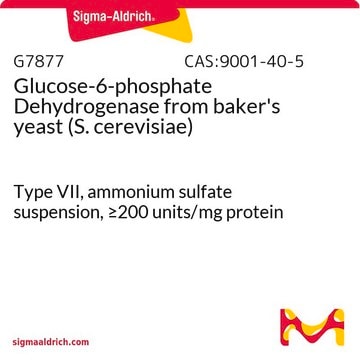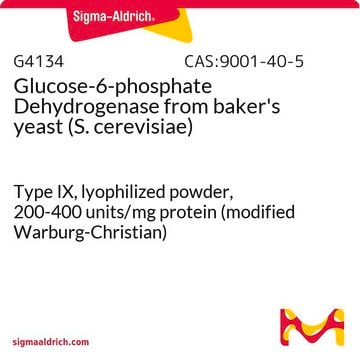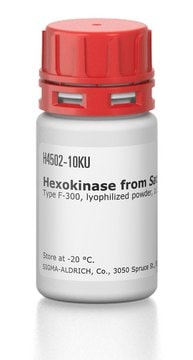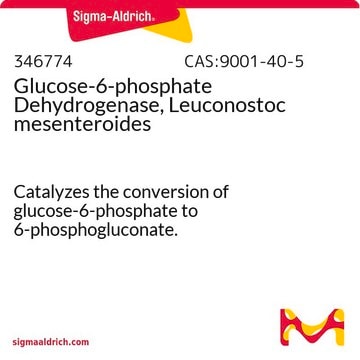To reconstitute dissolve G6378, Glucose-6-phosphate Dehydrogenase, in water and a dilute buffer. Following reconstitution, it should be refrigerated at 4°C, with stock solutions remaining stable for up to 6 months at this temperature.
G6378
Glucose-6-phosphate Dehydrogenase from baker′s yeast (S. cerevisiae)
Type XV, lyophilized powder, 200-400 units/mg protein (modified Warburg-Christian)
Synonym(s):
G-6-P-DH, Zwischenferment
Select a Size
Select a Size
About This Item
Recommended Products
type
Type XV
Quality Level
form
lyophilized powder
specific activity
200-400 units/mg protein (modified Warburg-Christian)
mol wt
128 kDa
purified by
crystallization
application(s)
diagnostic assay manufacturing
shipped in
dry ice
storage temp.
−20°C
Looking for similar products? Visit Product Comparison Guide
Related Categories
General description
Application
Biochem/physiol Actions
Unit Definition
Physical form
Preparation Note
Signal Word
Danger
Hazard Statements
Precautionary Statements
Hazard Classifications
Resp. Sens. 1
Storage Class Code
11 - Combustible Solids
WGK
WGK 3
Flash Point(F)
Not applicable
Flash Point(C)
Not applicable
Personal Protective Equipment
Choose from one of the most recent versions:
Certificates of Analysis (COA)
Don't see the Right Version?
If you require a particular version, you can look up a specific certificate by the Lot or Batch number.
Already Own This Product?
Find documentation for the products that you have recently purchased in the Document Library.
Customers Also Viewed
Protocols
To measure glucose-6-phosphate dehydrogenase activity, beta-nicotinamide adenine dinucleotide phosphate is used in a spectrophotometric rate determination assay at 340 nm.
-
What are the recommended reconstitution and storage procedures for item G6378, Glucose-6-phosphate Dehydrogenase from baker's yeast (S. cerevisiae)?
1 answer-
Helpful?
-
-
What are the Km values for Product G6378, Glucose-6-phosphate Dehydrogenase?
1 answer-
The Km values for glucose 6-phosphate and NADP are 2.0 x 10-5 and 2.0 x 10-6 , respectively in Tris buffer, pH 8.0 containing 10 mm magnesium chloride at 38°C.
Helpful?
-
-
What is the Department of Transportation shipping information for this product?
1 answer-
Transportation information can be found in Section 14 of the product's (M)SDS.To access the shipping information for this material, use the link on the product detail page for the product.
Helpful?
-
-
What does Type XV mean in the description of Product G6378, Glucose-6-phosphate Dehydrogenase?
1 answer-
The type designation Type XV is a Sigma in-house designation and does not represent any kind of biochemical significance. It simply refers to the order of addition of the product to the catalog (i.e., first there was a type I, then a type II, etc.).
Helpful?
-
-
What is the activity and protein content of the lot number of Product G6378, Glucose-6-phosphate Dehydrogenase, I have?
1 answer-
The protein content and the specific activity of the enzyme can be found on the lot-specific certificate of analysis.
Helpful?
-
Active Filters
Our team of scientists has experience in all areas of research including Life Science, Material Science, Chemical Synthesis, Chromatography, Analytical and many others.
Contact Technical Service








